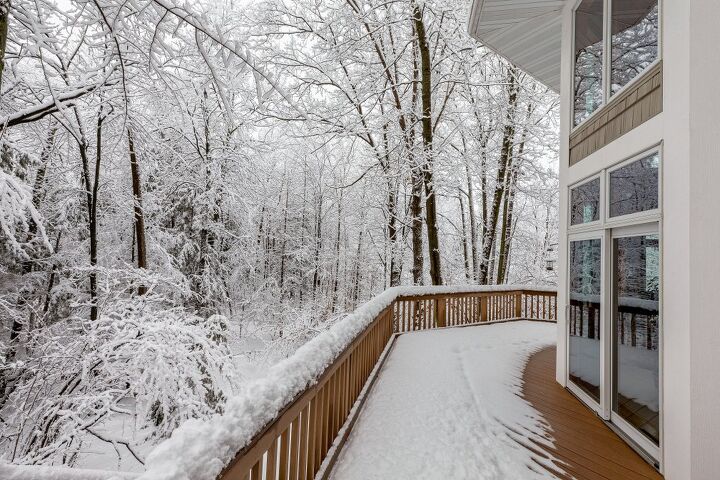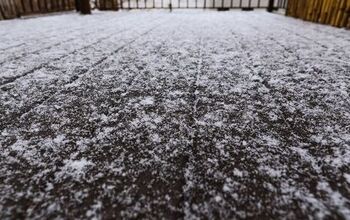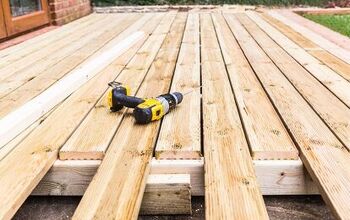What Can You Put On A Wood Deck For Ice? (Find Out Now!)

Wood decks are extremely popular additions to backyards on many homes. These areas provide extra room for entertaining and relaxing while enjoying your landscape or pool. However, in areas prone to ice and snow, many people wonder what to use on their wood decks when ice becomes a problem.
In general, to control ice on your wood deck, you want to avoid ice melt products that are sodium-based, like rock salt and some other products. Calcium-based products are the best choice for clearing your ice without damaging the surface, finish, or wood. Calcium products also don’t do as much harm to your landscape as sodium-based products.
There are many other products on the market for clearing ice and snow from outside surfaces. However, the finish on your deck and the wood material require special considerations. Finding the right ice melt product for your wood deck is important to preserve its beauty and integrity for many years.
Do You Need Snow Removal Services?
Get free, zero-commitment quotes from pro contractors near you.

About Your Wood Deck and De-Icer Products
Wood has been the preferred building product for years. The ease with which it can be worked and its durability add to the popularity. The strength-to-weight ratio of wood is good and makes it a preferable product for wood decks and other outdoor structures. However, wood does have some properties that need special care.
Porosity and Absorption
Since wood started as a living plant, its cellular structure makes it porous after it is felled. The porous nature of wood lends it to damage when water and other contaminants enter the pores and are absorbed into the wood.
Moisture in the wood is then subject to expansion and contraction with the temperature, which can eventually cause the wood to split, crack, or warp. Putting a sodium-based de-icer on your wood deck can infuse the salt into the wood, causing even more problems.
Salt (sodium chloride) only works down to about 20 degrees Fahrenheit. After that, and the salt-laden water will start to freeze again. If the wood has absorbed the salt-laden water, the effect of thawing and refreezing on the wood is made worse.
Calcium-based ice melt products work down to -25 degrees Fahrenheit, providing much more protection to your wood deck. The calcium de-icer will continue to melt ice down to this temperature offering greater protection and better results on your deck.
Finishes and Surfaces
Abrasive de-icers like sand and sodium (salt) based de-icers are highly abrasive. These products tend to remain on the surface of your deck after the ice has melted. As you walk on these abrasive materials, they can damage the finish on your deck or the wood surface.
Sand will provide some ice protection. Sand works by creating a non-slip rough surface on the ice but doesn’t actually melt the ice. Rock salt will melt the ice to a certain extent but only at more moderate temperatures. Both products may remain on the surface of your deck after the ice is gone. Both sand and rock salt can damage the finish and wood of your deck.
Calcium products dissolve almost immediately as they contact the ice. This makes them more effective at melting the ice and leaves no abrasive residue when the ice is gone. Therefore, you needn’t worry about any sharp or abrasive residue on your wood deck.
Metal Components Of Your Deck
The wood of your deck is not the only vulnerable part of your deck to damage from ice melt products. The wooden connectors and fasteners used to build your deck can be damaged by ice-melt products.
Sodium ice melt products can be extremely corrosive to metal fasteners and connectors on your wood deck. Sodium salts can attack the screws, bolts, and metal hangers used on many decks. The corrosive action of sodium can shorten the lifespan of your deck.
Calcium-based products tend to be much less corrosive and damaging to the metal components of your deck. This can prevent premature failure of the metal components and reduce the staining on your deck from corrosion.
More Efficient Ice Removal
Calcium-based ice melt is more efficient at removing ice than sodium-based products or sand. But, as we mentioned, sand doesn’t melt ice. Instead, it merely provides a rougher surface on the ice to prevent falls or slips.
Sodium-based ice melt products do melt ice but only down to 20 degrees Fahrenheit. After that, the water will refreeze, and the salt deicer stops melting ice. This makes sodium-based ice melt less efficient and less economical to use.
Calcium-based ice melt will work down to -25 degrees Fahrenheit. The wider range of effective temperatures makes calcium-based ice melt more efficient and more economical to use. You won’t need as much to do the same job.
Be Ecologically Friendly
Sodium-based ice melt products are not environmentally friendly. However, the sodium chloride used in many ice melt products can damage landscape plants in your yard. What you do this winter may come back to haunt you in the spring and summer.
The runoff from heavily treated areas can also affect some animals adversely. This is especially true of aquatic plants and animals. For example, if you have a fish pond, the sodium salts can be toxic if the concentration is too high.
Calcium-based de-icers have much less effect on landscape and wildlife. These types of de-icers are considered much more environmentally sound than sodium-based ice melt. If you have concrete in the area surrounding your wood deck, it will also fare better with calcium ice melt products.
The Pros and Cons
Each product has advantages and disadvantages. You should consider all of these before you decide which product is best for your wood deck.
Pros – Rock Salt
- Rock salt is cheap
- Works best at temperatures between 32 and 20 degrees Fahrenheit
Cons – Rock Salt
- It can damage plants and wildlife if the concentrations get too high.
- Corrosive to metal
- Rock salt can damage concrete, asphalt, brick, and stone
Pros – Calcium Chloride
- Is effective between 32 and -25 degrees for better ice melt results.
- Less likely to damage plants, landscapes, or wildlife
- Fewer problems with corrosion of metal deck components
Cons – Calcium Chloride
- More expensive than rock salt
Do You Need Snow Removal Services?
Get free, zero-commitment quotes from pro contractors near you.

Protecting Your Wood Deck From Ice
There are several ways to remove ice from your wood deck. Each has its advantages and disadvantages, and you must weigh those against your situation. Our recommendation is to use a calcium-based de-icer whenever possible to protect your wood deck and your family.

Dennis is a retired firefighter with an extensive background in construction, home improvement, and remodeling. He worked in the trades part-time while serving as an active firefighter. On his retirement, he started a remodeling and home repair business, which he ran for several years.
More by Dennis Howard
















![Standard Dining Room Table Dimensions [for 4, 6, 8, 10 and 12 People]](https://cdn-fastly.upgradedhome.com/media/2023/07/31/9074335/standard-dining-room-table-dimensions-for-4-6-8-10-and-12-people.jpg?size=350x220)










